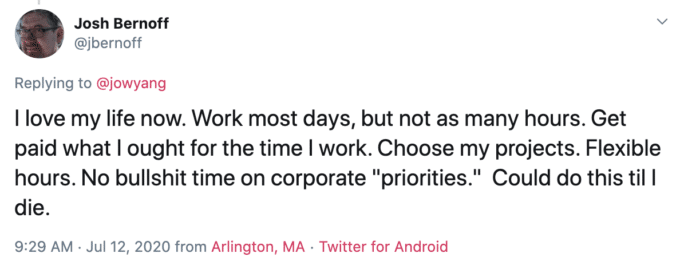Why is Culture Change Such a Strategic Priority?
Culture change is a hot topic in organizational development and leadership circles and for good reason; there is finally a growing understanding of its impact on the performance of organizations. The economics of culture change is driven by culturally normed behaviors. Culture acts as a powerful controlling determinant. Culture determines how quickly an organization can pivot, react to crises, and pursue new opportunities.
The less trust there is in a culture and between groups within it, the more structural force and extrinsic motivators are required to create and deliver products and services. Francis Fukuyama’s treatise Trust is a newly relevant read on how social structures impact wealth, prosperity, and economic growth.
The Employee Value Proposition has Decreased Dramatically
Organizations have traditionally used extrinsic motivators to maintain performance and productivity – initially physical force and more recently economic pressure. You can read more about how this evolved in my musings while on sabbatical. In any negotiation, coordination or collaboration information is power. Historically large organizations had much greater access to information than individuals in negotiating wages and salaries. This gave rise to unions and associations, which restored some balance but far too many individuals were still left to their own individual resources. Along came the Internet and with it, the explosion of access for everyone, which has dramatically increased the power of individuals to understand, pursue, and negotiate options.
This tweet, from Josh Bernoff, perfectly encapsulates this trend – smart, well-connected individuals who understand and can communicate the value they offer will create a work life that fits their unique interests, needs, and circumstances.
Jim Storer and I co-founded The Community Roundtable because we could not find an employment model that worked for us. We didn’t want to maximize salary at the expense of our personal and family lives – and we didn’t want to sacrifice doing interesting and valuable work either. What we’ve found is the ability to do valuable work much more productively and with people we truly enjoy – but work that gives us plenty of flexibility and time to invest in our personal relationships. We are not forced to compromise.
Organizations will likely never be able to get many individuals back into full-time fully committed roles – at least not in the way those positions are currently constructed. This trend will continue for the most valuable individuals. Far from the typical gig worker who serves at the mercy of commoditized, atomized tasks with little security, these are people with the leadership skills and experience to negotiate for the career they want. Many others will follow. Over time this will hollow out organizational leadership and expertise, leaving only the more risk-averse and complacent, who will reinforce the status quo making it almost impossible for organizations to change.
The COVID-19 pandemic, and its rapid acceleration of virtual work, has added even more competitive pressure on organizations because it is clear that many jobs can be done remotely, giving even more flexibility and options to employees. How do organizations compete and keep employees when they have less and less power to dictate employment terms, and employees have more power to define what kind, how much, and from where they contribute value?
Employees Want Security AND Meaning
In communities, the bulk of the power and control lies with individual members. Individuals determine how, when, and how much they participate and they are driven to do so primarily by intrinsic motivators – things that cannot be influenced by force. Intrinsic motivators include the need to cooperate, the joy of riffing and playing with others, the pursuit of new challenges, and the search for meaning; all the things that drive online gaming, open-source software development, and any healthy community.
Intrinsic motivators are so powerful that people will volunteer considerable amounts of their time and money to their pursuit, creating immense loyalty to causes, movements, and communities in the process – as well as accepting lower salaries to work in cause-related organizations. These intrinsic rewards are what allow individuals to thrive, making them feel alive and worthwhile. But people also need extrinsic rewards in the form of money, food, insurance, and health care to ensure physical security.
Organizations that can offer the extrinsic rewards people need PLUS the intrinsic rewards that offer deep satisfaction are the ones that will thrive in an environment where people have much more power and choice.
Jessica Jackley, founder of Kiva sums this up perfectly. Money is nice but Money + Love will always win.
The Knowledge Economy Changes the Dynamics of Work
When most work done by individuals was in production, coercion worked. One unit of work could be standardized to exchange consistently for a unit of extrinsic reward or force – the proverbial carrot or stick. It was considered a fair exchange but it never maximized productivity – it standardized, moderated, and made production predictable. This helped organizations manage risk but it also capped potential.
The bulk of production tasks will soon be completed by machines, robots, or algorithms. The unique value that people can add is in their creativity, perspective, innovation, and energy. Those outputs are neither standard nor are they specific transactions that can be turned on and off. To produce creativity, innovation, and energy organizations must engender behaviors and habits that, over time, cultivate unique outputs. To generate these, organizational culture must reinforce and normalize different behaviors. More than behavior, however, is that creativity and exploration require people to care, both for their own work and the work of others. Organizations cannot care. Only other people can care. What organizations CAN do is create the environment and manage the boundaries around who cares and who does not – creating the conditions that generate both the extrinsic rewards that people want and need to both live and thrive.
Communities Support and Normalize Change
Communities have long been a requirement of human potential. People thrive when their communities support who they are and challenge them to grow into their best selves. Communities are ever-changing and evolving – they are complex adaptive systems that can quickly respond to individual needs.
Organizations are taking note and intentionally fostering internal, employee-facing community ecosystem to address organizational and culture change. Community programs are increasingly integrated with digital transformation efforts.
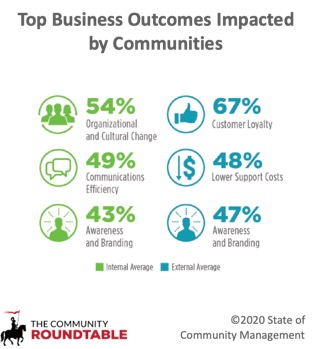
What we know from successful, healthy, and productive communities is the following:
- Measuring engagement behaviors and how work happens is as important, if not more, than measuring outputs and transactions.
- Aligning, hiring, and leading requires a compelling shared purpose that is bigger than the organization and is meaningful to every participant in the community.
- Management needs to focus on the system; business model and exchange rates for different kinds of value, infrastructure, programming, and managing boundary conditions rather than on managing the work and tasks of individuals.
- Decision-making needs to be maximally inclusive but with clear responsibility for resolution given to specific individuals.
- Leadership needs to be distributed and an attribute that is given to those who are motivated and influential, rather than something bestowed upon people based on their role and structural authority.
- Learning, growth, and exploration need to be built into the structure in a way that diversity becomes a feature that is maximized and celebrated instead of a bug that is moderated.
- Metrics and progress need to focus on behaviors, not content.
This community-based business model is a powerful driver of commitment and loyalty – both for employees and customers. It too requires investment before it pays off – but the dynamics of that investment and the return happen differently. In this year’s State of Community Management report we were able to quantify this investment and, interestingly it has a similar curve to other types of business investments but the focus is on normalizing new behaviors and motivators using a relationship-centric approach vs an infrastructure-centric one. Both are needed by the primary means of influencing change changes.
Community Business Models are Generative
While communities change the balance of power between organizations and individuals – and give individuals more control over how they work – the real power of communities comes in their ability to rapidly distribute and share value. The challenge is that community value takes time to build and the value of communities has been mostly implicit. Over the years, my work has focused on making community dynamics and value more explicit – creating TheCR’s Community ROI model and investing my time in deep research to better understand the investments required for organizations to maximize community value.
Initially, communities are small and experimental and require human facilitation and relationship building. As the community consolidates around and norms behaviors that generate shared value, the cost per member goes up because infrastructure can now be built to make those behaviors consistently easy and rewarded. Once that is completed, the cost per member of communities drops precipitously.
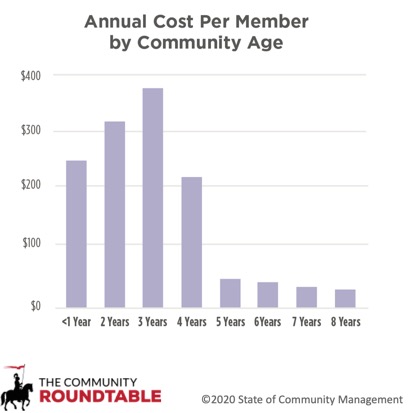
This cost model is rewarded by a compounding growth in value generated by the community, which flattens as the shared purpose of the community gets addressed and fulfilled.

The biggest difference in community business models is that investment and returns are more equitably shared – while communities CAN have sponsors that invest in them, that is not necessary. Members of the community, compelled by the shared value that motivates them intrinsically, contribute their attention, curiosity, time, and expertise. By sharing the value contributed by every member, the value compounds as more and more people join the community and benefit from it – creating a generative value loop.
In this year’s research, we translated the investments of both organizations in the form of management, investment, and programming, and by members in the form of attention, questions, and expertise. We did this by dividing the average community program cost per member (the organizational investment) and the average answers contributed per member across communities and multiplied it by the average value of answers (the member investment). We then looked at the rewards of communities. For organizations, we looked at the engagement and expertise provided by members that offset the need for the organization to invest in providing it. For members, we looked at the average number of answers they accessed in a year and multiplied that times the value of an answer.
The results were compelling – generating ROI not just for organizations but also for each individual employee.
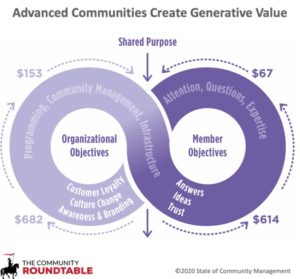
As compelling as the results are, they are also profound.
Looking at how communities generate value we see that by sharing the value generated, it can increase the value… of its value. Sharing knowledge allows more people to apply it – and more people to build off of it rather than repeating its creation. It allows innovation to happen much more quickly.
Communities Fuel Innovation
This is the power of the Internet if you think of it as a global community that increases transparency and access to information. The result is increasingly fast innovation and adoption cycles of new technology.
What smaller communities – organizational communities – add is an increase in trust focused on a more specific objective. This focus is required to innovate around increasing complex challenges; challenges like global health pandemics, climate change, health care delivery, and education.
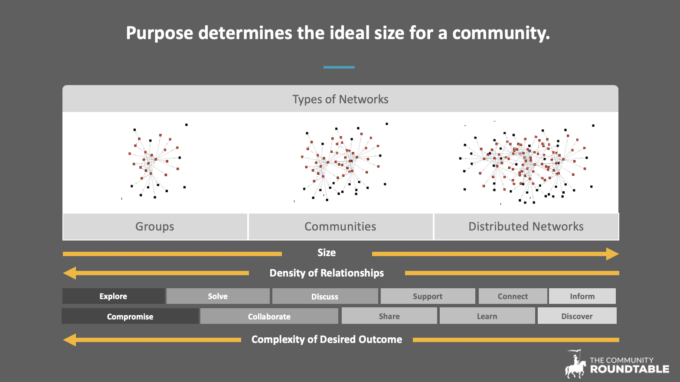
The question for organizational executives is no longer should we intentionally invest in the development of communities but…
…will we survive if we don’t invest in community development?
